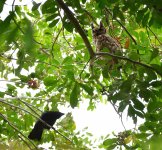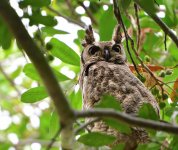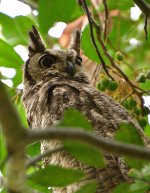Spectrum805
Member
I have been using the set up described in posts #10, 11, 12 for 1.5 months now. I thought I should give a description of my user experience so far for those who are still interested in this topic. Again thanks every one for the variety of opinions on this thread, I am learning something new very frequently from other's experiences.
Overall, I am very happy about the versatility of going from (1) Binoculars (2) Telephoto lens (3) Astronomical telescope (80mm f6 Orion ED80T-CF) in quick succession without having to worry about fixture change. Let me use one example that happened today to illustrate this point: I got woke up very early by a commotion in the backyard and ventured out to see what's going on. It turned out a flock of crows were mobbing a great horned owl on a neighbor's tree. I was able to quickly grab the tripod/gimbal and long lens (70-200 f2.8 with a 2x teleconverter) to take some photos/videos. (See photos attached, a video of the crows mobbing the owl at:
) By early evening, the same crazy noise came back again, as suspected, the same owl is now on another neighbor's tree, the light was already too dim for photography (and the spooky moon was up and in the same direction of the owl), so I grabbed the Orion 80mm APO with 10mm Ethos, on the same tripod and gimbal mount to watch the fight for a little while. My friends (who are also into bird watching, so I called) arrived a few minutes later, the sky was even darker, so I switched to binoculars (15x56) to have larger exit pupil at a lower mag, and wider view surround the owl for situation awareness. It is handy to grab the whole set up with one hand and mount whatever I feel mounting at the last minute and do so very quickly, without having to think about tooling, as no tool is needed. Over the last month or so, the configuration I used most is with the 15x56 bino on Gitzo series 2 mountaineer tripod and the gimbal. The latter two is 7.2Lbs, adding the big bino with iphone plus a heavy-duty case and phone adapter makes the total 11Lbs. With this, I no longer carry my SLR camera and long lens for local area hiking. Just this set up and a bottle of water is all I need to disappear onto a trail for several hours, and the longest hike I did carrying this equipment configuration was 8 miles. This is also my default set up for San Diego Wild Animal Park and the Zoo, where there are plenty of birds to see, and use iphone for casual digiscoping. I also used this tripod/gimble set up (sometimes switching to the heaviler systematic series 5 tripod) with the Orion 80mm telescope for very casual stargazing in the backyard. I no longer bother to collapse the tripod. Just lift the whole thing in one hand, and in two minutes I can be looking at something in the sky (causally). It can go to a maximum elevation angle just shy of 80 degree, which is pretty decent. For any bright object that the naked eyes can see the direction, this set up works well.
Now let me focus on the three things I don't like, so that others who are reading this can have realistic expectation on the limitations: (1) It works very well for birds at a distance or perched birds at a close distance. However, if I have to change focus drastically in quick succession, the gimbal balance needs to be adjusted with the focus. Such an adjustment is a two-hand operation, I was not able to keep track of the birds while doing it. So if a bird is moving very fast, toward or away, near zero drag setting is impractical. I would have to increase the drag so that it become less sensitive to imbalance, but this partially defeat the main selling point of the photographic gimbal, which is nearly friction free. (I have not used dedicated spotting scope, but I suspect the imbalance issue would be significantly less because the focus would be internal so less weight distribution changes.) (2) Because the telescope uses a 90 degree star diagonal, while my binoculars is a straight through, the required tripod height for comfortable viewing is very different. For quick toggles between the two, I have to put the tripod low and extend the center column when using binoculars. Photographers would laugh at such an amateurish approach of extending the center column, but it is acceptable to my taste because I am using an extremely stiffest tripod and center column, with a 88 Lbs load rating, where my load is less than 10 Lbs. The main situation when the stiffness of the light-weight gimbal become a concern is under extremely windy conditions, it happens in less than 1/5ths of the time, such as on hilltop next to the ocean. In such a case, visual is fine, but digiscoping is not (also because the wind noise becomes very loud in any video). (3) The gimbal mount is only compatible with long lens with built-in tripod collar, which allows one more dimension of freedom to compose (like in the owl photos). If you want to compose in arbituary orientation without a tripod collar, you still need a ballhead. So if you want to take a tripod mounted family photo on gimbal, in addition to a nodal plate, frequently it requires better leveling of the set up by changing the extension length of one or two of the tripod legs on lens without a tripod collar. I found it somewhat cumbersome.
So overall I am quite happy with the trade-off. It was the best compromise I was able to come up with for my type of relatively casual but flexible applications. My focus was the lightest possible set-up that can be shared across the platform. Even for this set up, I found it is only practical to carry all three types of gears if they are in a car trunk. If I have to venture away from the car by more than half a mile, I will at most carrier two of the three, and much more likely just one of the three. Hope this information is of use for someone who has similar needs in the future.
Haibo
Overall, I am very happy about the versatility of going from (1) Binoculars (2) Telephoto lens (3) Astronomical telescope (80mm f6 Orion ED80T-CF) in quick succession without having to worry about fixture change. Let me use one example that happened today to illustrate this point: I got woke up very early by a commotion in the backyard and ventured out to see what's going on. It turned out a flock of crows were mobbing a great horned owl on a neighbor's tree. I was able to quickly grab the tripod/gimbal and long lens (70-200 f2.8 with a 2x teleconverter) to take some photos/videos. (See photos attached, a video of the crows mobbing the owl at:
Now let me focus on the three things I don't like, so that others who are reading this can have realistic expectation on the limitations: (1) It works very well for birds at a distance or perched birds at a close distance. However, if I have to change focus drastically in quick succession, the gimbal balance needs to be adjusted with the focus. Such an adjustment is a two-hand operation, I was not able to keep track of the birds while doing it. So if a bird is moving very fast, toward or away, near zero drag setting is impractical. I would have to increase the drag so that it become less sensitive to imbalance, but this partially defeat the main selling point of the photographic gimbal, which is nearly friction free. (I have not used dedicated spotting scope, but I suspect the imbalance issue would be significantly less because the focus would be internal so less weight distribution changes.) (2) Because the telescope uses a 90 degree star diagonal, while my binoculars is a straight through, the required tripod height for comfortable viewing is very different. For quick toggles between the two, I have to put the tripod low and extend the center column when using binoculars. Photographers would laugh at such an amateurish approach of extending the center column, but it is acceptable to my taste because I am using an extremely stiffest tripod and center column, with a 88 Lbs load rating, where my load is less than 10 Lbs. The main situation when the stiffness of the light-weight gimbal become a concern is under extremely windy conditions, it happens in less than 1/5ths of the time, such as on hilltop next to the ocean. In such a case, visual is fine, but digiscoping is not (also because the wind noise becomes very loud in any video). (3) The gimbal mount is only compatible with long lens with built-in tripod collar, which allows one more dimension of freedom to compose (like in the owl photos). If you want to compose in arbituary orientation without a tripod collar, you still need a ballhead. So if you want to take a tripod mounted family photo on gimbal, in addition to a nodal plate, frequently it requires better leveling of the set up by changing the extension length of one or two of the tripod legs on lens without a tripod collar. I found it somewhat cumbersome.
So overall I am quite happy with the trade-off. It was the best compromise I was able to come up with for my type of relatively casual but flexible applications. My focus was the lightest possible set-up that can be shared across the platform. Even for this set up, I found it is only practical to carry all three types of gears if they are in a car trunk. If I have to venture away from the car by more than half a mile, I will at most carrier two of the three, and much more likely just one of the three. Hope this information is of use for someone who has similar needs in the future.
Haibo
Attachments
Last edited:







